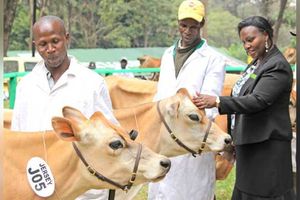Farmers upgrade cattle breeds to boost milk yields

David Kobaai attends to his herd of crossbred cattle at his Kajiado Central farm on March 23, 2024.
What you need to know:
- World in Data projects that demand for animal products will increase by 70 per cent by 2050.
- Because of these growing demands, scientists say African countries should embrace investment in technological innovations, new sciences and out-of-the-box thinking by agriculturalists to change the narrative.
Pregnant cows with hanging udders at a zero grazing unit on a farm in Kajiado are indicators that David Kobaai is a thriving livestock keeper.
When the Healthy Nation team arrives at Mr Kobaai’s 42-hectare farm, he is tending to his crossbred livestock.
Mr Kobaai has taken livestock rearing a notch higher by embracing artificial insemination to improve the quality of cattle breeds and increase milk production
"I am in contact with a local veterinary officer, who brings semen for specific breeds. An insemination attempt may fail once or twice, but it usually succeeds," Mr Kobaai says.
His tall cattle breed is from Switzerland, which he settled on after thorough inquiry in the wake of climate change when droughts have become more frequent.
Mr Kobaai, who is also the Ngong Municipality manager at Kajiado County Government, says he is happy to have embraced crossbreeding two years ago.
"There is a huge difference if you compare the quantity of milk I get from local cows and that of crossbreeding. Currently, I have about six cows ready to give birth and each can produce 30 litres daily. This means crossbreeding is profitable," he says.
He is one of the pastoralists in the country who have embraced the artificial insemination technology to keep livestock on a smaller piece of land, eliminating the need for cows and calves to walk for long distances in search of pastures and water.
“I bought the first breed — Pure Friesian — at Sh160,000. It was a little costly because it was nearly calving. It gave birth to a Swiss breed. I keep the improved Sahiwal because of its high quality. We sell one between Sh120,000 and Sh130,000 to a customer who wants to import semen," Mr Kobaai says. However, he notes that crossbreeding has some potential drawbacks. Apart from the initial cost of getting the foreign breed home, he reveals that rearing them is costly, from feeding them to training herdsmen who attend to them to watch for signs when the cow is in heat.
Mr Koobai notes that local livestock are a bit resistant to Coast Fever and Foot and Mouth unlike the crossbred ones. The area also reports Rift Valley Fever, mainly during the rainy season.
"We still have a lot of ticks here and most of the crossbreeds are not resistant to the ticks. So, they become sick, especially when there is Foot and Mouth. But they are enclosed since I have fenced my farm, and thus there are few attacks," says Mr Kobaai.
Scientists at the International Livestock Research Institute (ILRI) are currently studying the epidemiology of the Rift Valley Fever virus, African swine fever, Newcastle disease and climate-aggravated infectious diseases like those caused by arboviruses.
"Rift Valley Fever is caused by a zoonotic pathogen infecting humans and animals. Almost 80 per cent to 100 per cent of pregnant animals infected with the fever will almost certainly abort, so it is an important pathogen for agriculture and also in the context of one health," says Dr Samuel Oyola, senior scientist and head of Genomics at ILRI. Just like Mr Kobaai uses artificial insemination technology to have crossbreeds, ILRI also uses AgriGenomics, the application of genomics in livestock, at its Nairobi campus.
Dr Oyola says the technology helps reduce the time scientists spend developing new animal vaccines. This helps develop solutions to challenges for new breeds such as those faced by livestock farmers using the insemination technology like Mr Kobaai.
"In the case of Rift Valley Fever that we are working on here, we have developed tools that support the capture of genomic materials and sequencing. We use the sequenced data to monitor the circulating traits and this helps us see similarities and differences within the samples collected from different places based on our scientific ability to analyse the mutations," says Dr Oyola.
As an international research institution, ILRI uses thousands of global databases, including those from Eastern, Central and Western Africa and South Asia.
Dr Eunice Machuka, a research officer at the institution, says that through AgriGenomics, they have observed that different breeds of cows respond differently to infections.
"Advanced technology in the lab enables us to know the mechanism of infection, how the virus can modulate the infection and make the animal really sick. Some cows are resistant while in others an infection can stay longer in body. In some, an infection is cleared in a shorter time, depending on how fit a cow is," Dr Machuka says.
Prof Appolinaire Djikeng, director-general at ILRI, says data showed an increase of 50 per cent in milk production in countries like North America and Europe when farmers introduced AgriGenomics in their dairy production.
"AgriGenomic helps us maximise the limited space we have and the pressure we have to deliver more food within a specific length of time. I think developing new varieties is important, and without the use of AgriGenomics, you'll not be able to do it," notes Prof Djikeng.
World in Data projects that demand for animal products will increase by 70 per cent by 2050. Because of these growing demands, scientists say African countries should embrace investment in technological innovations, new sciences and out-of-the-box thinking by agriculturalists to change the narrative.
"Providing food during severe drought is a short-term solution, and we have been doing it for the last four decades. It is now time to produce food in a futuristic way. Leveraging technology is what will provide a long-term solution to hunger on the continent," says Prof Anne Muigai, a professor of genetics who is also the chair of the African BioGenome Project.





